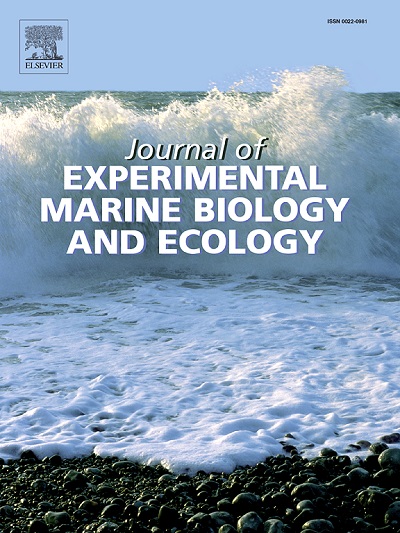Effects of elevated temperature on erosion of Saccharina latissima (Laminariales, sugar kelp) blades
IF 1.8
3区 生物学
Q3 ECOLOGY
Journal of Experimental Marine Biology and Ecology
Pub Date : 2025-01-01
DOI:10.1016/j.jembe.2024.152071
引用次数: 0
Abstract
The critical role of kelp as an ecosystem engineer (nutrient cycling, habitat formation) is well recognized but under threat. Recent declines in natural kelp populations worldwide have been linked to global warming-induced rising temperatures of the ocean. There is, however, a noticeable gap in knowledge about the effects of temperature on the erosion of (distal parts of) the kelp blades. This erosion process, where blades tissue is lost, is crucial to understanding kelp health and nutrient dynamics in marine ecosystems. This study aimed to quantify the erosion rate of Saccharina latissima (Laminariales, sugar kelp) blades and the subsequent release of total organic carbon and total nitrogen during erosion under naturally increased temperatures (from 16.1 °C to 22.5 °C) and further elevated temperatures (from 16.1 °C to 27.1 °C). A significant increase in the erosion rate of the distal parts of blades was observed in both temperature treatments. Substantial amounts (4.24 ± 0.31 mg cm−2 of C and 0.32 ± 0.13 mg cm−2 of N) of nutrients were released from S. latissima, especially under sub-lethal temperature conditions. Under further elevated temperatures, with a prolonged period of higher temperature and a maximum temperature of 27.1 °C, the effects were stronger, and erosion occurred along the edges of the whole blade. Our findings suggest that rising temperatures accelerate the erosion of S. latissima blades, highlighting a reason for the decline of kelp forests under climate change, as well as the potential impacts on nutrient cycling in the oceans.
温度升高对糖藻叶片侵蚀的影响
海带作为生态系统工程师(营养循环,栖息地形成)的关键作用已得到充分认识,但受到威胁。最近全球自然海带数量的减少与全球变暖导致的海洋温度上升有关。然而,关于温度对海带叶片(远端部分)侵蚀的影响的知识存在明显的差距。这种叶片组织丢失的侵蚀过程对于了解海洋生态系统中海带的健康和营养动态至关重要。本研究旨在量化在自然升高温度(从16.1°C到22.5°C)和进一步升高温度(从16.1°C到27.1°C)下,Saccharina latissima (Laminariales,糖海带)叶片在侵蚀过程中的侵蚀速率以及总有机碳和总氮的释放。在两种温度处理下,叶片远端部分的侵蚀速率显著增加。在亚致死温度条件下,毛茛释放了大量的营养物质(C为4.24±0.31 mg cm−2,N为0.32±0.13 mg cm−2)。在进一步升高的温度下,高温持续时间越长,最高温度达到27.1℃,影响越强,整个叶片边缘都发生了侵蚀。我们的研究结果表明,气温上升加速了海带叶片的侵蚀,突出了气候变化下海带森林减少的原因,以及对海洋营养循环的潜在影响。
本文章由计算机程序翻译,如有差异,请以英文原文为准。
求助全文
约1分钟内获得全文
求助全文
来源期刊
CiteScore
4.30
自引率
0.00%
发文量
98
审稿时长
14 weeks
期刊介绍:
The Journal of Experimental Marine Biology and Ecology provides a forum for experimental ecological research on marine organisms in relation to their environment. Topic areas include studies that focus on biochemistry, physiology, behavior, genetics, and ecological theory. The main emphasis of the Journal lies in hypothesis driven experimental work, both from the laboratory and the field. Natural experiments or descriptive studies that elucidate fundamental ecological processes are welcome. Submissions should have a broad ecological framework beyond the specific study organism or geographic region.
Short communications that highlight emerging issues and exciting discoveries within five printed pages will receive a rapid turnaround. Papers describing important new analytical, computational, experimental and theoretical techniques and methods are encouraged and will be highlighted as Methodological Advances. We welcome proposals for Review Papers synthesizing a specific field within marine ecology. Finally, the journal aims to publish Special Issues at regular intervals synthesizing a particular field of marine science. All printed papers undergo a peer review process before being accepted and will receive a first decision within three months.

 求助内容:
求助内容: 应助结果提醒方式:
应助结果提醒方式:


